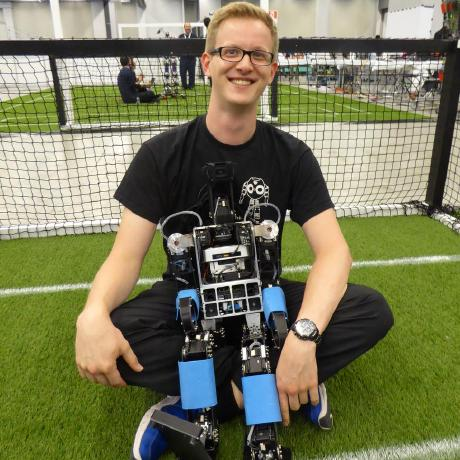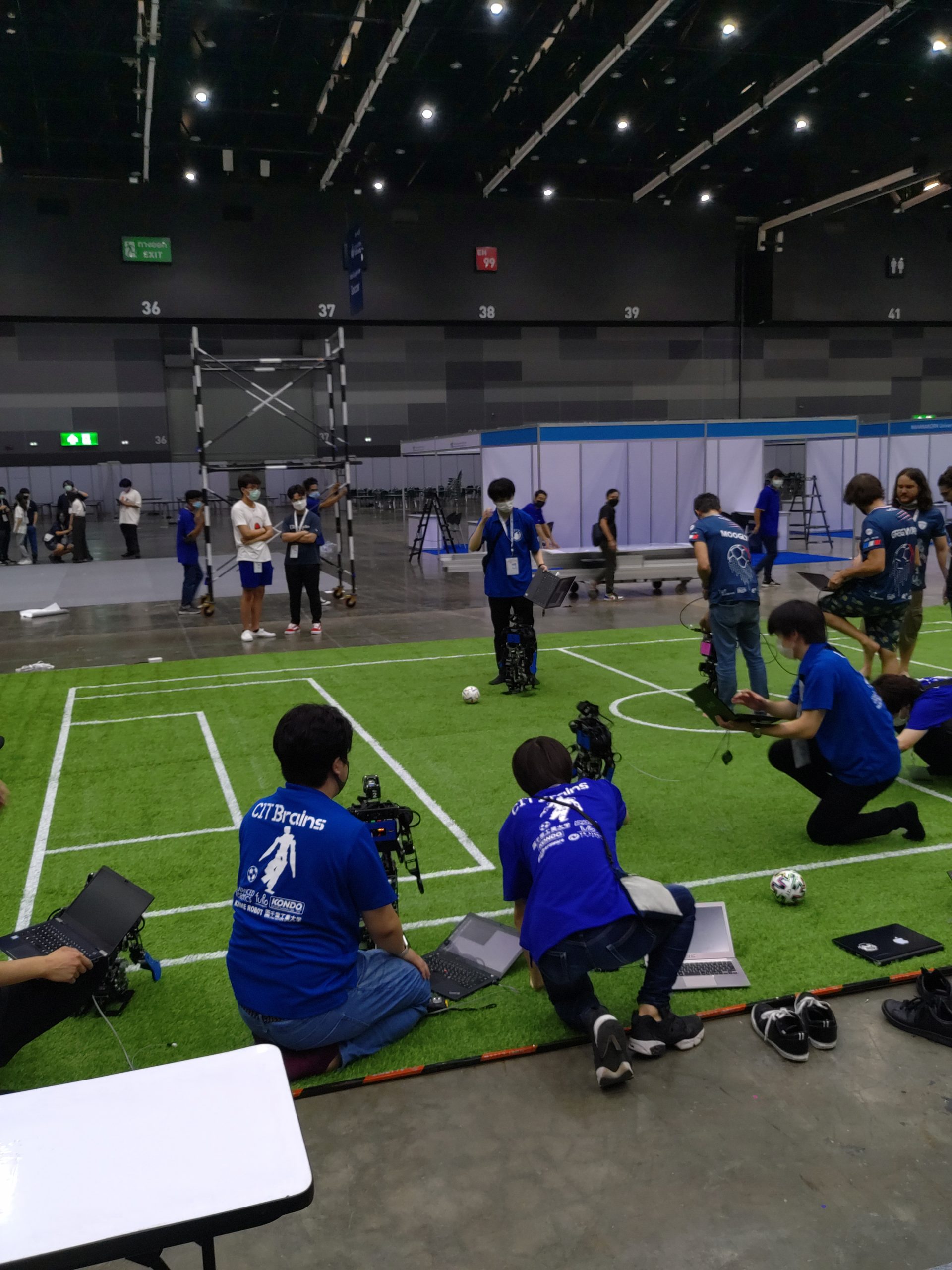
Robohub.org
RoboCup humanoid league: Interview with Jasper Güldenstein

RoboCup is an international scientific initiative with the goal of advancing the state of the art of intelligent robots, AI and automation. The annual RoboCup event returned to an in-person format for 2022, taking place from 13-17 July in Bangkok. RoboCup comprises a number of leagues, with perhaps the most well-known being the soccer leagues.
In the Humanoid League, autonomous robots with a human-inspired body plan and senses play soccer against each other. We spoke to Jasper Güldenstein, a member of the technical committee, about the competition at RoboCup 2022, and also about the Humanoid League Virtual Season. As a biweekly virtual competition taking place between the physical RoboCup events it provides teams with an opportunity to test their ideas and keep in touch throughout the year.
Could you give us an overview of the Humanoid League competition at RoboCup this year?
This year we had the first in-person event after a three year break. It was really good to have the majority of the teams coming back together and working on their robots again. Although a lot of teams came with fewer participants than they usually do, we still managed to have 12 teams in the kid size league and three teams in the adult size. Unfortunately, some teams could not participate due to travel restrictions, but we hope to see them back next year.
 Humanoid league finalists with their robots
Humanoid league finalists with their robots
What was the format for the competition?
At the beginning we had a drop-in round, which is where we play games with one robot from each team participating in a joint team. So, we have eight robots playing from eight different teams. That is useful for finding out which teams are likely to perform the best in the competition. Next, the results from the drop-in games were used as seeding for the round robin phase of the regular competition, with the strongest teams separated into different groups. After the round robin, we have a knockout competition. The seeding method means that we can hopefully avoid the situation where very good teams get kicked out early. We saw that the most interesting games were towards the end of the competition when the teams performed really well.
Have you noticed improvements since the last physical competition?
I’d say definitely that one big thing that has improved for a lot of teams is the localisation. A lot of teams are more easily able to localise themselves on the field, and they don’t run off randomly. They are more certain that they are in the correct position.
Furthermore, I think the kicking has improved. The robots kick the ball much further than they used to. People have been tuning their kicking motions to increase the distance.
In terms of computer vision, this has definitely improved quite a bit. Something we did differently this time, which was inspired by what we did in the virtual season, is that we had a set of six different balls, all from previous FIFA competitions. For each game a ball was drawn randomly, so the teams couldn’t really prepare for all the balls. Although they were visually quite different, the teams didn’t really have any problems detecting the ball. We’ve seen, in general, that computer vision approaches have improved and these improvements have been transferred to the RoboCup competition. I think that almost all teams are using a neural network to detect the ball. This is a change from three, four, five years ago, where many teams used hand-tuned classical computer vision algorithms.
To talk a bit more about ball detection, it will be interesting to see what happens if we move to an environment with natural and/or varying light conditions. This year we were in a convention hall with uniform lighting. I believe next year, in Bordeaux, there is going to be some form of natural light coming in, and perhaps even fields that are outside. It’s still at the planning stage but we are looking forward to that. It will be a challenge and I strongly believe that the participants will find approaches to make their vision approach robust against these varying conditions.
 The setup and testing for the Humanoid League competition at RoboCup 2022, Bangkok.
The setup and testing for the Humanoid League competition at RoboCup 2022, Bangkok.
Thinking about the transfer from the simulation to the real world, are there any specific elements that lend themselves well to being transferred?
In terms of computer vision, we had a bit of transfer. In the virtual season we concentrated a lot on changing the lighting conditions and having varied backgrounds, to be able to emulate the real world a bit better. I think a few teams used their vision approaches from the virtual season in the real world.
However, I think the strongest part is behaviour. Teams were able to test their strategies in the virtual competition and adapt every other week. For example, CIT Brains, which won the virtual season and the physical competition, made quite a few changes to their strategy and they had robust systems running. Their strategy worked really well, and in the final they managed to score several goals win against the previous world champions (Rhoban Football Club).
How did the competition go for your team (Hamburg Bit-Bots)?
We actually had quite a few hardware problems, especially on the mechanics side. The motors are wearing out and warped due to wear, and flexed more than we expected. This meant we had difficulties walking stably. And, if you can’t walk in a stable manner that defeats the purpose of everything else. It’s a really integrated system – if one component breaks, you are out of luck as you are very restricted in what you can change during the competition as you don’t have much spare equipment with you.
However, what was good for us was that we had a lot of software up and running, and a lot of it had been tested really well during the virtual league. We had to try and find a way round the walking problem algorithmically, to try to find walking parameters that were more stable. We also switched from [robot operating system] ROS 1 to ROS 2 which brought with it many challenges. We actually did a write up on the issues we faced, with some tricks and tips.
Will there be a new virtual league season this year?
Yes, we’ve discussed this in our technical committee and we plan on doing it again. The last event was successful and the teams enjoyed it. We plan on making some changes, such as logging the games to extract some interesting metrics and doing some analysis on those.
Another thing we want to do is domain randomisation, making the environment a bit more varied. This means that the approaches have to be more robust. The hope is that, when they are more robust, they can be transferred more easily to the real world. We were thinking about making the terrain slightly uneven. Another approach could be to modify the models of the robots such that the joints emulate a bit of wear, so they simulated actuators might be a bit weaker or stronger randomly, and teams have to find robust approaches to deal with that.
We won’t do everything at the beginning. We’ll move through the season and talk to the teams and form some organising groups to develop the simulation further, to run the games and to organise the competition itself. We are always happy to have input and we always talk to the teams to see what they think. It’s a competition but it’s something we build together.
 Humanoid robots at RoboCup 2022, Bangkok.
Humanoid robots at RoboCup 2022, Bangkok.
Could you tell us about the satellite event that took place at RoboCup?
This was a discussion about how to get teams more interested in participating and how to bridge the junior leagues and the major leagues.
We know that some people who participated in RoboCup Junior specifically selected a University that has a RoboCup team so that they could join that team. It would be awesome for more people to do this, and for more juniors to know what the major league is about.
To bridge the gap between the junior and major leagues we don’t want to introduce another league, but we want some form of events where the two groups can meet, and where the juniors can show off how well they are doing. It would be good to have more interaction between the leagues, although we haven’t decided on the exact format yet.
About Jasper

|
Jasper Güldenstein is a PhD student at University of Hamburg. His research focuses on humanoid navigation. He has been participating in RoboCup as a member of the Hamburg Bit-Bots since 2016 where his focus is developing not only the software of the team but also the electronics of the robot platform. In his recent master thesis he evaluated using reinforcement learning to perform path planning and execution for humanoid robots. |
tags: c-Events, interview






